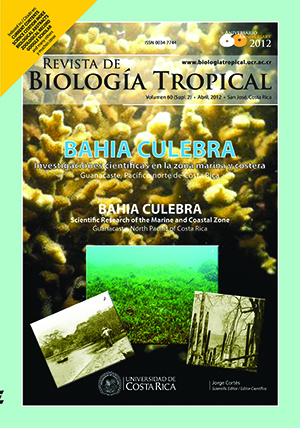Abstract
We studied the annual patterns of composition, abundance and spacial-temporal distribution of mesozooplankton in the upwelling zone of Culebra Bay, north Pacific coast of Costa Rica, during the 1999 La Niña event and in 2000. The Bay showed a high variability in physical-chemical conditions during the study period in which 26 mesozooplankton groups (both meroplanktonic and holoplanktonic forms) were found. The copepods (2 358.53 ± 2 290.90ind/m³), ostracods (1 084.46 ± 1 850.20ind/m³) and invertebrate eggs (844.26 ± 7069.27ind/ m³) were the most abundant groups in Bahía Culebra. All mesozooplankton (0.2-2 mm) data showed high spatial- temporal variability although differences were not significant. Higher abundances were found during 1999, with the exception of appendicularians and crustacean larvae. Higher zooplankton abundances were observed during the dry season of both years. Stations close to the mouth show an oceanic influx of holoplanktonic forms, while inside the bay, the meroplanktonic forms were important. Mesozooplankton abundance and distribution were influenced by coastal upwelling pulses.Comments
Downloads
Download data is not yet available.






